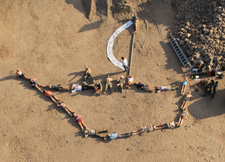Publications
- Publication Strategy
- Bibliography
- Preliminary season reports
- Full season reports
- Tel Dor Staff Manual (2013 version)
Publication Strategy
The lag (and sometimes lack) of final publication has been described as 'the dirty secret' of archaeology the world over. It was clear at the outset that even partial fulfillment of such a broad program as is outlined herein necessitates the combined resources of quite a few researchers and institutions, sustained over many years. Special steps were taken to ensure that the breadth and length of the project should not delay the prompt publication of the finds. These include interim publication, parallel research efforts, the encouragement of advanced students to embark on Dor-related research, and the opening of the data to outside expertise.
Rather than delay the final report indefinitely, a strategy of publication by area was adopted. After an area has been opened for a few years and has demonstrated its potential, specific research goals for that area are defined. Once these are fulfilled, the area is closed down (usually by a winding-down process, which may take a few seasons) and prepared for publication.
As an area's excavation is sufficiently advanced, and its research objectives are coming to fruition, a publication forum for that area is assembled. This forum includes the principle investigators who will write the main chapters of the report for that area. It usually includes the directors of the relevant areas, and sometimes other members of the areas' staff, as well as experts in the major topics in which that area has most to contribute. Other contributions (from the Tel Dor staff or outside it) are solicited as needed. This decentralization of the research effort ensures that several publication forums can work concurrently.
The Tel Dor expedition encourages its staff members and advanced students to collaborate, under its auspices, in independent Dor-oriented studies and spin-off projects. While the final publication proceeds according to excavation areas, such semi-independent projects may integrate data from several excavation areas, as well as include other sites or topics which exceed the agenda of the Tel Dor project as such. These extra-curricular studies are natural candidates for student papers, thesis proposals, articles in professional journals, etc. The project advocates such activity, on the premise that each staff member is entitled to publish his or her own work and ideas. Inter-disciplinary and inter-institutional cooperation in such projects is encouraged. The results of this policy may be seen in the bibliographical list. Two Ph.D. dissertations based to a large extent on Tel Dor data are currently under way, and several MA theses have been, or are being written, on topics concerning Tel Dor.
Subjects for which there is no in-house expertise on the Dor staff are tendered to outside specialists. Contrary to the understandable instinct to hoard important finds until the director, or one of the other principle investigators, have time to publish them - the policy at Tel Dor is that the finds are best published by whoever is best equipped to do so immediately. This disposition is evident not only in opening the data base to scholars and students who request access to specific finds, but in actively seeking outside authorities who will undertake to independently study and publish such topics. Finds from Dor have been, or are being studied by scholars from University of Minnesota, The American School of Classical Studies in Athens, Tel Aviv University, Haifa University, and other institutions (in addition, of course to those active in the consortium itself).
The medium of final publication is the Qedem Reports series, published by the Hebrew University. Two excavation areas, A and C, have already been published. The manuscript of Area G is in print. Two other publication forums - for areas B-early and D-late, are already currently active.
